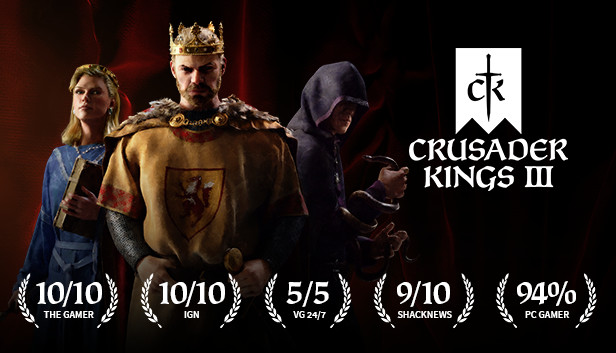Crusader Kings 3 (CK3) is a medieval strategy and management game that places you in charge of guiding an entire dynasty through hundreds of years. It is the long-awaited sequel to Crusader Kings 2, and it does not disappoint.
Any new players interested in starting with Crusader Kings 3 will likely meet a fairly sharp learning curve initially. Even if you have played Crusader Kings 2, there are still quite a few subtle differences that can stump you in your first few rounds. This list of beginner tips will hopefully help with getting you started in Crusader Kings 3!
See our Piety and Prestige Guide here, our Succession and Inheritance Tips here, and our Top 10 Tips for Starting as a Count here.
1. Fabricate Claims using the Bishop (or other religious leader)
This is one of the biggest changes since Crusader Kings 2. Instead of the Chancellor, it is now the religious leader that is used to fabricate claims. Another change is that it is no longer a randomized chance that rolls every year – there is simply a progress bar that fills up for the claim to occur.
The speed of progress and whether or not you receive a duchy claim instead of county claim is dependent on the skill of the bishop. Typically it can take around 1-2 years for the county claim to go through and it costs around 70-100 gold to claim. Please also keep in mind that you cannot be negative in gold to start a war so have some saved up in advance.
2. Learn the basic hotkeys
There is a LOT of clicking that goes into Crusader Kings 3. It is definitely worth learning the basic hot keys for bringing up menus if you plan to play for any longer than a couple of hours. Here are the simple ones that I like to use:
- F1: Character Screen
- F2: Realm
- F3: Military
- F4: Council
- F5: Court
- F6: Intrigue
- F7: Factions
- F8: Decisions
- 1-5: Game speed (5 is extremely fast, be warned)
- Space: Pause and Play
- E: Regular Realm map toggle
- T: Cultural Map
- R: Religious Map
- U, I, O: Duchy, Kingdomg, Empire Titles (shows them regardless of whether or not they’re formed)
- W, A, S, D: Map Movement
- B: Go back to previous menu
There may be other hotkeys people use, but these are the ones I’ve run into so far that I consistently use all the time. The escape key is just the usual button for exiting out of tabs. However, if you are trying to get rid of only the “Issues” menu then hit Tab instead since the Escape key will exit out of everything else first.
3. Increase County Control using your Marshall as soon as possible
Control makes a huge difference in how much levy and taxes you receive from a county. Anything below 50 Control will be a huge hit to what you can receive. It is usually worth sending your Marshall in to return Control back to 100 as soon as you are out of a war. This is actually one of the mechanisms that Paradox included to prevent snowballing since it’ll increase how long it takes for you to reap the benefits of new counties.
One caveat to this is if you are expecting someone to initiate another war with you in a short period of time or if you have a really great claim on someone who is momentarily weak. In this case, keep your Marshall on the “Organize Levies” tab for the extra Levy Size and Reinforcement Rate. However, during peace time increasing Control is much more important than increasing levies or improving commanders.
4. Christian Rulers can ask the Pope for Gold – use this ability early game
You can easily get anywhere between 125 to 200 or so gold as a Christian ruler in exchange for 250 Piety and a temporary decrease in relationship with the Pope. To qualify, it is best to have a good opinion score, some virtue traits, and as few sins as possible. There generally isn’t a good reason to not take the gold especially in the early stages of the game.
If you start off as a Duke or King, gold problems will likely still be at the front of your mind. Piety is a resource that does play a big role in being able to wage Holy Wars, but gold can usually take you a lot further. You need gold to pay for starting up your Men-at-Arms Regiments and to hire Knights with high Prowess. Without this fighting ability, it is hard to wage wars in the first place. Take the gold and think about Piety later.
Once you hit the part of the game where you are interested in reforming religions or embarking on Holy Wars, check out our Prestige and Piety guide here for how to obtain Piety.
5. Hover over information for a few seconds before moving to the tooltip
Once you wait around 3 seconds or so, the information bubble changes borders and sticks around for you to move your mouse onto it. For example, if I want to check my Monthly Income breakdown, I would hover over the tab so that the information bubble pops up, wait for around 3 seconds for the border to change, then move my mouse onto the bubble itself. Hopefully this helps with preventing any mild annoyances about getting the information bubble to stick around.
Alternatively, you can go into the “Game” section of the settings and change the Tooltips to Action lock or Mouse Tendency. This will give you a bit more freedom in choosing what you prefer. I personally stuck with the original method since I hate having to click again and again for the tooltips.
6. Forbid Sons with low Prowess from being Knights
Found this out the hard way when 3/4 of my sons died in the same battle. If they don’t have high prowess then they are much, much more likely to be killed in battle. Keep in mind that Martial and Prowess are two completely different values that represent different things. Martial is the main value you usually see that represents their ability to command troops – it is also the value you use to select for a good Marshall. Prowess is the ability to actually fight, you can see a person’s prowess when you look to the right of the main stats and see the hand grasping a sword.
To forbid a person from being a knight, hit “F3” to bring up the Military Menu, click on the Knights menu, scroll to your sons and select “Forbid”. In some cases, you might even want to keep your heir safe and forbid them even if they have a high prowess score. Things can randomly happen in battle and sometimes avoiding the risk altogether can be better for your dynasty.
One other thing to keep in mind is that some characters have the “Brave” trait. This trait increases the character’s chance of dying in battle by 100% while offering a few bonuses to combat ability. It is great that some characters are monsters and can carry a fight, but don’t let that character be your only heir (unless that is what you are role-playing). Keep an eye out for this trait specifically just in case!
7. You can increase Men-at-Arms regiment sizes directly
Simply click on the regiment portrait to bring up the menu and hit “Increase Size to ____”. This gives you more variety in which Men-at-Arms types you want to bring into battle with you. The overall cost would still be the same since the size upgrade is the same as the initial buy cost, but you get to hire different types of regiments as a result.
8. Diversify your Men-at-Arms Regiments
Unless you did some extra work in scouting out your enemy’s troops when they fought in other wars, it is difficult to determine which regiments they will be bringing to the fight. The “counter” mechanism can limit your opponent fighting efficiency by up to 90% if it is a direct counter. For example, instead of your Armored Footmen dealing 32 Damage, it’ll only deal around 3 if the opponent brings a unit of Skirmishers to the fight.
Diversifying your regiments gives you a much better chance at negating your opponents and having at least some of your regiments do full damage. This might not always apply depending on cultural troop availability and terrain, but if you are all over the map then this gives you the most flexibility. If you follow tip #7 as well, then you should have no issues with adapting your army to the enemy you are expecting to fight.
9. Bring Mangonels or Onagers if you are sieging
They are cheap compared to other regiments and the decrease in overall time required to siege down a castle is definitely worth it. Instead of the default 1.0 progress per day, you now have 1.6 with Mangonels (1.3 with Onagers). This is a boost of 50% – meaning instead of 3 months to siege down a city, you now have to only wait for 2. If you are fighting any other kingdom or even duchy, the time you save can literally be the difference between victory and defeat.
If you are worried about cost – don’t be! The total for a Mangonel is 0.32/month when raised while a regiment of skirmishers is 0.44/month. For the benefit that it brings for sieges, this should be at least the third regiment you pick up.
The big downside to this is that they have no bonuses to fighting power during regular field battles. The opportunity cost lost here is that you could have afforded another unit of bowmen or skirmishers that might have been handy if it was a close battle. Buying this regiment third would be a good balance between improving your fighting ability and your siege ability.
10. Choose the right Commander
A good commander can influence a battle a ton and even win you fights where your army is objectively weaker. Having a higher tactical score is one thing, but many good commanders also have traits that give bonuses in certain terrain types or to increase damage altogether. Selecting the right commander means you sometimes have to override what the automatic selection is and carefully look through the traits of who you have available.
To change commanders, highlight your army and hit the “Select new Commander” button in the very lower left corner of your screen. Sometimes this button will be greyed out if you are either in battle, or were recently defeated and the army is still retreating. It is usually a good idea to hit that button right when you raise army just to be sure there aren’t any better choices for commanders.
11. Be mindful of River Crossings and Boat Landings
You get a fairly large debuff whenever you are trying to attack someone across a river. It is a much more defensible position and can easily give the weaker army enough of a bonus to win the battle. Taking the long way around might be less time efficient, but it avoids getting you into sticky situations. This is also one of the areas I started paying a lot more attention to than I did in Crusader Kings 2 since I saw many of my armies get wiped by the mechanic.
Likewise, any army that just got off the boat will have a debuff that makes them much less effective. If you are defending against an invading army, stopping them right at the shore is usually one of the best tactics to maximize your winning opportunity.
12. Read through all the Lifestyle Perks
Some of the bonuses from these perks go beyond just being percentage based increases to character ability. For example, the Diplomat Tree has a perk called “Forced Vassalage” that unlocks the “Forced Vassalization” Casus Belli. It is a great way to start wars straightforwardly instead of having to either wait for fabrication or going through the whole process of finding and landing a claimant.
It is also worth reading the tooltips for these new abilities since they can give you a much better idea of what character you could be building into. Using the same example, the “Forced Vassalization” Casus Belli is initially restricted to only being valid on Rulers that have no more than 3 Counties in their realm. However, it can be further improved based on the cultural innovations you pursue. Once you have innovations like “Divine Right” and “Rightful Ownership”, it can increase the vassal realm size by 2 each. Knowing this, you can now tailor your cultural innovations to these specific ones if you are the cultural head.
Reading through the tooltips for all of the perks can be tedious, but it will give you a ton more role-play value and give you greater customization of how you want to play the game.
13. Start with Petty King Murchad in 1066 to explore mechanisms
This is a really common tip but it is one worth repeating. It is considered to be one of the best starting situations for learning since it gives you a really great opportunity to explore the various ways to expand your territory and provides you with advantages over all of your immediate enemies.
You start the game with one County for yourself and one for your vassal while everybody else in Ireland starts with just one. Already this is enough for you to win the De Jure war that you begin with. From there, you can experiment with the “Fabricate” function or learn how to obtain claims through marriage or landing claimants. It is also a situation that forces you to be good with your money since you really have to save up for the men that you want to buy.
Once you have unified Ireland into a Kingdom, you can then experiment with larger-scale intrigue and claiming systems like marrying off your son to one of the lesser noblewomen that still have a claim to England. You will usually encounter issues like rejections due to Patrilineal Marriage concerns which give you a realistic taste of what the rest of the game could be like.
14. Adapt to your character traits
Unlike Crusader King 2, Crusader Kings 3 has a much higher importance placed on traits and how they affect character interactions. Playing every single chractert you use as a Warrior will inevitably lead to your demise. Look at the traits, perks, and stats that your character has and determine which lifestyle would best suit their abilities. From there, read through the possible perks and explore the new mechanisms they unlock. This way you can fully experience the full extent of features the game has to offer.
I initially started with purely going the same strategist/commander character playstyle, but once you being dabbling in other treas like stewardship and diplomacy you begin to realize there are a ton of other options out there. A stewardship focused King can literally generate enough income to max out a stack of men-at-arms and still have some to spare for Mercenaries. Slap on a good commander in your court and you’re set to conquer the world.
My point here is that Crusader Kings 3 opens up a ton of replay and role-play value. Even if you just want to paint the world in the colour of your Empire, there are many different ways for you to do so. I hope that this tip gets you exploring into the diversity that exists in the game.
Conclusion
Crusader Kings 3 definitely lived up to the hype for me and I hope that this list of beginner tips will help you enjoy the game in the same way. There are ton more features in this game and I will do my best to cover them for you. Please comment below if there are any specific questions you have or if you have any other tips that you want included in the guide!
Thank you all for reading and I hope you have a great time conquering 🙂
See our Piety and Prestige Guide here, our Succession and Inheritance Tips here, and our Top 10 Tips for Starting as a Count here.
Please follow me on Twitter and Facebook for consistent updates on my guides and reviews!





Pingback: Crusader Kings 3 Prestige and Piety Guide - Kijin Gaming
Pingback: Crusader Kings 3 Succession and Inheritance Tips - Kijin Gaming
Pingback: Crusader Kings 3 Top 10 Tips for Starting as a Count - KijinGaming
Pingback: Crusader Kings 3: How to Play Tall Guide and Tips - KijinGaming